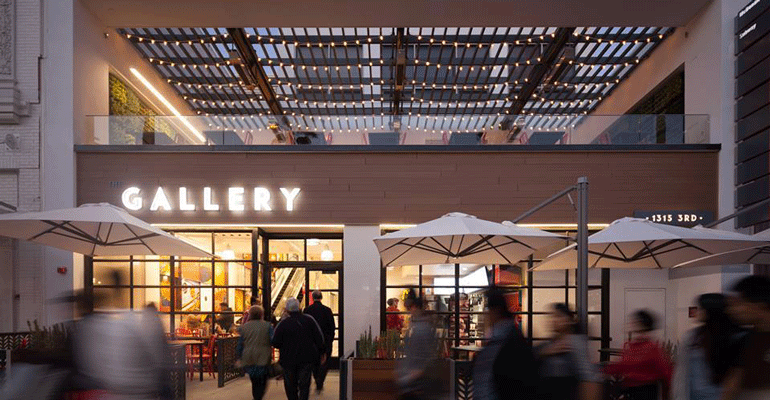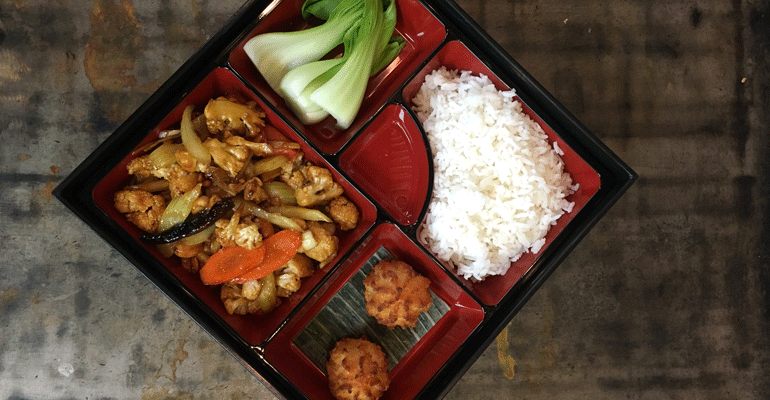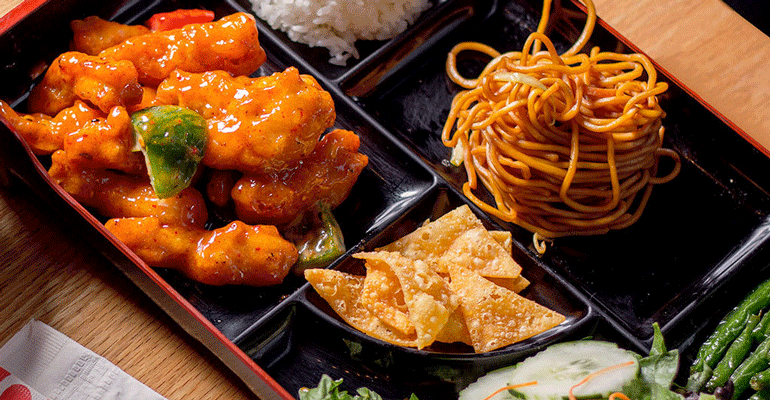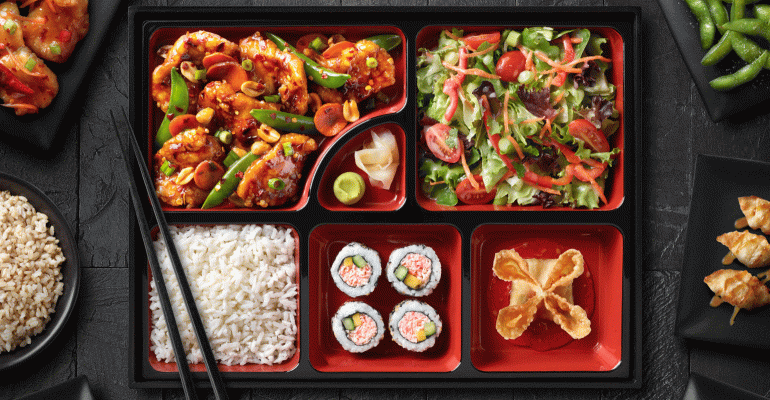Japanese-style bento boxes may have been around for centuries, but they’ve only recently been “discovered” by parents around the world who are making these compartmentalized lunchboxes for their kids. Now bento lunches are becoming a fast-casual trend too: With their grab-and-go structure and customizable compartments of rice, protein, and sides, bento boxes naturally fit into a fast-casual lunch format.
We’ve rounded up several examples of the emerging bento box trend in fast-casual restaurants, from a bento-only delivery concept to an already-emerging chain undergoing a major expansion.
Supertoro— Santa Monica, Calif.
Supertoro is an upcoming Japanese fast-casual, build-your-own bento box restaurant scheduled to open in the Santa Monica, Calif., Gallery Food Hall this summer. The concept, from SuperTrio Restaurants, is a collaboration between K2 Restaurants group — the parent group of the Gallery Food Hall — and Paul Medeiros of Medeiros Holdings, a Japanese holding company.
Supertoro has appropriated the popular build-your-own fast-casual menu trend for the traditional bento box lunch. For a price point of $11 to $15, customers will be able to choose from sushi hand rolls and cut rolls, starters like edamame and chirashi with ponzu sauce, proteins like spicy tuna and chicken katsu, and sides like soba or seaweed salad to create their own lunch box.

“Today’s generation values variety and customization and aren’t always happy with a one-size-fits-all menu,” John Kolaski, owner of K2 Restaurants said. “We are noticing a rise in bento box varieties in the fast-casual space which makes sense as today’s consumer gravitates toward a dining lifestyle change of portioned, easy grab and go food in a visually appealing format.”
The bento boxes will also be available for delivery though Uber Eats, Postmates, and Grubhub, and will be delivered in to-go packaging specifically designed for temperature control so that the lunch boxes will travel well.
After Supertoro opens this summer, Kolaski has plans to expand the concept further, with two further undisclosed locations planned.
Kelley and Ping
Although the Kelley and Ping delivery-only bento box concept in Boulder, Colo. just opened in January, the brand has been around since 1993. Brad Kelley and his former business partner originally owned a casual noodle restaurant and Asian market in New York, but the restaurant closed in 2017 due to a gas leak.
After moving the brand to Colorado, Kelley noticed that there was a need in the market for casual Asian cuisine, and decided to open an eco-friendly delivery-only concept specializing in office deliveries to gain brand recognition before risking a brick-and-mortar location.
Working out of a shared satellite kitchen, Kelley and Ping offers a simple bento box-only menu, with four standard bento boxes and a rotating special, with compartments for proteins, vegetables, and rice or noodles with entrees ranging from $14-$16.

“The bentos are appealing because you’re not eating a huge plate of pad Thai, and then falling asleep at your desk the next moment,” Kelley said. “I lived in Japan for over a year and was always taken by the bento delivery system there … they deliver bento boxes and then pick them up in the afternoon. We are doing the same thing in Colorado, and we are essentially zero-waste.”
There are no immediate plan for expansion, but Kelley said, “Never say never.”
Pei Wei Asian Kitchen — Irving, Texas
The 167-unit Irving, Texas-based fast-casual chain, Pei Wei Asian Kitchen, just introduced customizable bento boxes on April 17. While the former P.F. Chang’s Bistro-owned chain is already known for its build-your-own Asian rice bowls, the bento boxes add a new level of customization to their fast-casual menu.
Customers will be able to choose a protein from chicken, vegetables, tofu, steak and shrimp; a type of rice from white, brown, or cauliflower; a sushi roll from spicy tuna, mango California, teriyaki crunch or wasabi crunch; a crab wonton or chicken potstickers for an appetizer; and a miso salad or edamame for greens, for 400 different menu combinations.
“The idea behind the Bento Box was that we wanted to highlight a variety of dishes that Pei Wei guests love and allow them to tailor their box to fit their own personal taste and preference,” Chef J. Sullivan, Pei Wei’s Director of Culinary Innovation said in an email.
Pei Wei Asian Kitchen was sold to private investment company Centerbridge Partners in 2017.
Bento Asian Kitchen + Sushi — Orlando, Fla.
Although Bento Asian Kitchen + Sushi — the fast-casual, Florida-based bento box and sushi restaurant with 13 locations and counting — has been in business since 2002, the brand is in the middle of a major expansion. Bento Asian Kitchen + Sushi has grown by 50% over the past year, and the company is on track to open seven more locations by the end of 2020.

Even though the fast-casual brand also has rice bowls, noodle bowls, poke bowls, and sushi on the menu, bento boxes are the brand’s biggest seller, according to a spokesperson for parent company Bento Group.
Customers can choose white or brown rice, ginger salad, lo mein or string beans, to be topped with a selection of entrees, including Mongolian, katsu, tempura, stir fry, and bulgogi in a variety of protein options for an average check of $10.
The original 2,000-square-foot location was founded and opened by brothers Jimmy and Johnny Tung just a couple of blocks away from the University of Florida in Gainesville. Now, each location is 3,000-square-feet, on average.
Contact Joanna Fantozzi at [email protected]
Follow her on Twitter: @joannafantozzi





